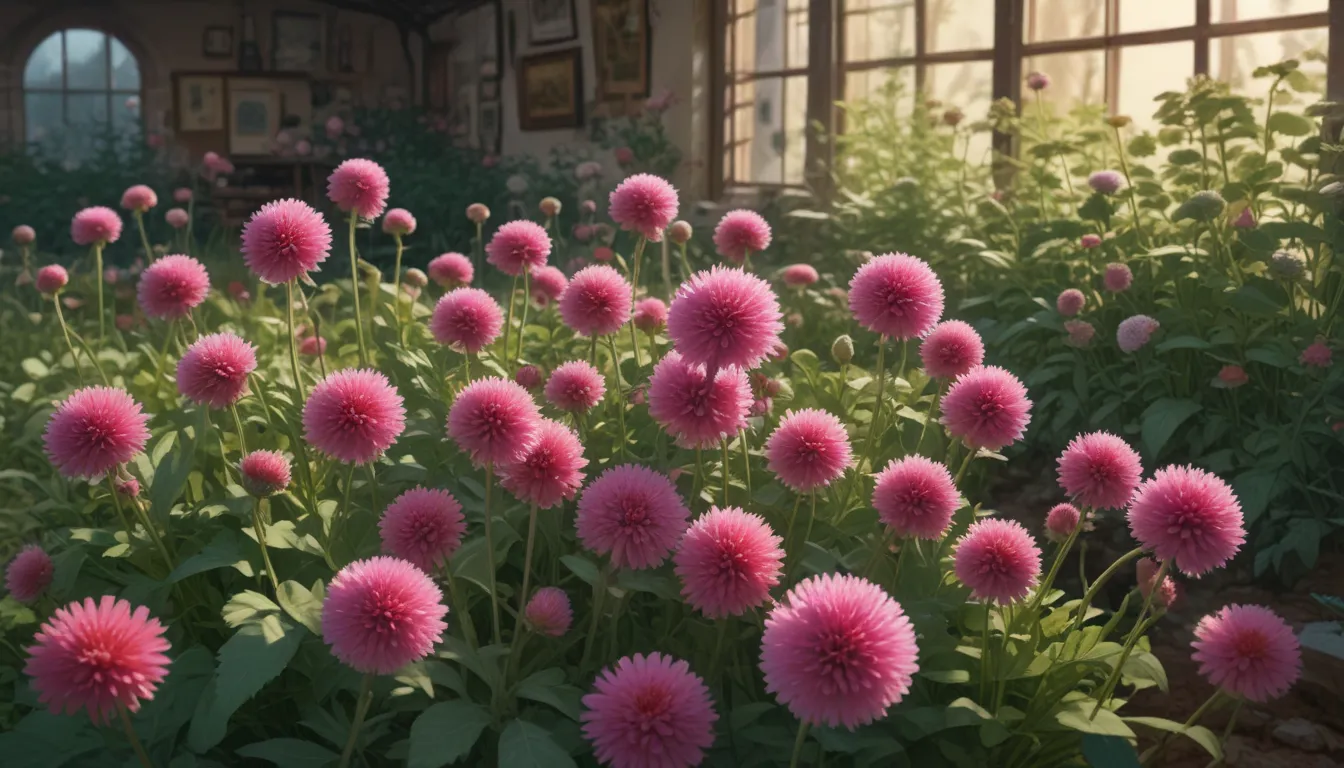The Ultimate Guide to Growing Globe Amaranth in Your Garden

Globe amaranth, also known as Gomphrena globosa, is a vibrant tropical annual that brings long-lasting, globe-shaped blossoms in an array of colors to your garden. Whether you’re new to gardening or have a green thumb, these unique flowers are a fantastic addition to beds, borders, rock gardens, and even xeriscapes.
In this comprehensive guide, we’ll delve into everything you need to know about cultivating globe amaranth in your garden. From its rich history to practical growing tips, we’ll cover it all to help you succeed in growing these delightful blooms.
The Fascinating World of Gomphrena Globosa
Globe amaranth belongs to the Amaranthaceae family, with Gomphrena globosa being one of the 90 species of flowering plants in this group. Originating in Central and northern South America, these classic magenta blossoms have made their mark on the landscape for centuries. Similar plants include love lies bleeding amaranth, cockscomb, and spinach.
The unique flower heads of G. globosa resemble clover, with stiff, papery bracts instead of petals. Each bract hosts a tiny white or yellow flower, creating a stunning visual display up close. These colorful blossoms are a treat for the eyes and have a timeless appeal.
Thanks to hybridization, globe amaranth now comes in various vivid shades such as lilac, magenta, pink, purple, red, orange, and white. These hues make them a versatile choice for any garden setting, adding pops of color and charm wherever they’re planted.
Planting and Growing Globe Amaranth
Cultivation and History
Globe amaranth is a tropical plant that thrives in heat and humidity while basking in the sunshine. With its long taproot, it can tolerate drought but prefers consistent moisture, especially during germination and early growth stages. Whether you have loamy or clay soil, good drainage is critical for these plants to flourish.
Getting Started
- Soil Type: Globe amaranth grows well in loamy to clay soil with exceptional drainage.
- Sunlight: Full sun is ideal for these plants to thrive.
- Watering: Maintain even moisture, avoiding oversaturation that can lead to fungal diseases.
- Fertilization: Minimal fertilization is necessary as an excess of nitrogen can result in abundant foliage rather than flowers.
- Spacing: Provide adequate spacing of 12 to 18 inches between plants for optimal growth.
Propagation
You can grow globe amaranth from seeds, but be patient as germination is slow and may take a few weeks. Start seeds indoors eight weeks before the last frost date or sow directly into the garden. Remember to soak seeds overnight and handle the delicate taproots with care to ensure successful growth.
How to Grow
- Transplanting: Wait until the last frost has passed and select a sunny location for planting.
- Watering: Provide consistent moisture, especially during the germination stage.
- Pinching: Pinch off flower buds for bushier growth and lusher blooms.
- Maintenance: Deadhead flowers regularly to promote continuous blooming and prevent legginess.
Tips for Successful Growth
- Tropical Care: Globe amaranth thrives in tropical conditions with heat and moisture.
- Avoid Overwatering: While they love water, be mindful of not overwatering to prevent fungal diseases.
- Low Maintenance: These plants are relatively low maintenance once established, making them an excellent choice for busy gardeners.
- Deep Taproot: Respect their deep taproot and plant them in adequately deep containers or soil.
Choosing the Right Cultivars
Selecting different cultivars of G. globosa allows you to enjoy a rich array of colors and sizes in your garden. Whether you prefer the subtle elegance of white blooms or the vibrant allure of pink and purple, there’s a variety to suit every taste.
Notable Cultivars:
- Audray White: Crisp white blooms on 18-inch stems add elegance to any garden setting.
- Fireworks: Giant blooms with hot pink bracts and yellow flowers create a show-stopping display.
- Mixed Gnome: A blend of pink, purple, and white flowers on petite six-inch plants perfect for containers and border fronts.
Experimenting with different cultivars can add depth and visual interest to your garden, creating a unique and personalized space that reflects your style.
Managing Pests and Disease
Globe amaranth is relatively resistant to pests and diseases, but a few common issues may arise. Keep an eye out for aphids and thrips, which can damage foliage and spread diseases. Treat them promptly with organic neem oil to keep your plants healthy.
Common diseases such as Alternaria leaf spot, Botrytis blight, damping off, and powdery mildew can affect globe amaranth under unfavorable conditions. Proper spacing, good airflow, and regular maintenance can help prevent these issues.
Protect your plants by ensuring they receive adequate sunlight, spacing them correctly, and maintaining proper hygiene in the garden to ward off pests and diseases effectively.
Harvesting and Uses
While globe amaranth is primarily grown for ornamental purposes, you can also enjoy the edible parts of the plant. From tender sprouts and young leaves to flowers, roots, and seeds, there’s a range of culinary and decorative options available for you to explore.
- Harvesting: Pinch off flower heads at the base for fresh blooms and dry them for long-lasting arrangements.
- Roots and Seeds: Harvest roots and seeds at the end of the season for culinary or propagation purposes.
- Drying: Dry flower heads to retain their vibrant colors for use in potpourri, floral arrangements, or natural dye.
Exploring the edible and decorative aspects of globe amaranth can add a new dimension to your gardening experience, allowing you to enjoy both beauty and functionality in your garden.
Best Ornamental Uses
Whether you choose compact varieties for small spaces or towering giants for a dramatic display, globe amaranth offers endless possibilities for ornamental use. From beds and borders to containers, rock gardens, xeriscapes, and window boxes, these versatile plants fit seamlessly into any setting.
Pairing globe amaranth with complementary plants such as celosia, marigold, Mexican petunia, salvia, and zinnia can enhance the overall aesthetic of your garden while attracting beneficial pollinators. Create stunning floral arrangements, centerpieces, and everlasting wreaths using these colorful blooms to add a touch of elegance to your home.
Quick Reference Growing Guide for Globe Amaranth
- Plant Type: Tender flowering annual, short-lived perennial
- Flower/Foliage Color: Lilac, magenta, pink, purple, red, orange, white/green
- Hardiness (USDA Zone): 2-11
- Exposure: Full sun
- Spacing: 12-18 inches
- Height: 6-48 inches
- Spread: 8-24 inches
- Water Needs: Medium
- Attracts: Bees, butterflies, and other pollinators
Refer to this quick guide for essential information on growing and caring for globe amaranth in your garden, ensuring a successful and rewarding gardening experience.
In Conclusion
Globe amaranth, with its stunning colors and long-lasting blooms, is a delightful addition to any garden. By following the tips and guidelines provided in this comprehensive guide, you can cultivate these unique flowers with confidence and enjoy their beauty throughout the growing season.
Experiment with different cultivars, explore the edible aspects of the plant, and create stunning arrangements to showcase the versatility of globe amaranth in your garden. With proper care and maintenance, these vibrant blooms will reward you with an array of colorful flowers that brighten your outdoor space.
Have you grown globe amaranth in your garden? Share your experiences and tips in the comments below. And for more gardening insights and inspiration, be sure to explore our other guides on growing flowers and plants in your garden.
With globe amaranth, the possibilities are endless, offering robust and everlasting beauty that transforms your outdoor space.
By incorporating practical growing tips, detailed information on cultivation and history, and valuable insights on choosing cultivars and managing pests and diseases, this enhanced article provides readers with a comprehensive guide to growing globe amaranth in their garden. Through engaging content and useful recommendations, this article aims to empower gardeners to cultivate these vibrant flowers successfully and enjoy their beauty throughout the growing season.





